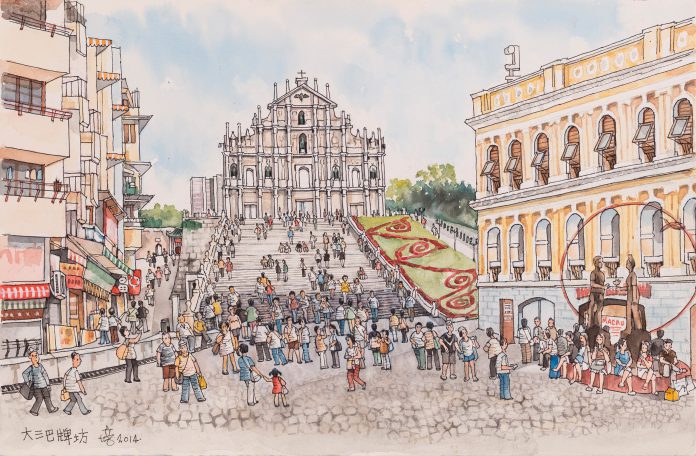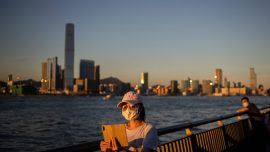Chan Iu Pui, who started painting in the 1950s under a teacher who “always brought us to sketch on the streets” says that during the 50s and 60s comics were popular in Hong Kong and Macau.
“At that time, drawing comics was a kind of high-paying job. Most of my comics reflect social problems,” he says, having witnessed the rise and decline of this industry, although his passion for drawing remains as ardent as ever.
 When movies started flourished in the 1980s and 1990s in Macau Chan became a poster painter, painting a lot of huge movie posters on billboards by hand.
When movies started flourished in the 1980s and 1990s in Macau Chan became a poster painter, painting a lot of huge movie posters on billboards by hand.
“Painting these posters feels like a person who drives a bus after driving small cars. In the beginning I was not used to it but the skills are the same. Practice makes perfect!” he laughs. “At that time I painted for the theatre in Jai Alai. Normally, the movie companies gave us a few different pictures to choose from. I chose the one I felt most confident in. People may ask, is it difficult to paint these large-scale pictures? Don’t worry, we used different sizes of tools to paint different size of picture!”
-1024x748.jpg) But time flies. In the blink of an eye, ten years have gone by. Printed posters replaced hand-painted posters and Chan became the last man standing in the industry.
But time flies. In the blink of an eye, ten years have gone by. Printed posters replaced hand-painted posters and Chan became the last man standing in the industry.
Upon retiring, he finally found time to indulge his passion for sketching, using his pen to record the streets and alleys of Macau, especially those charming old parts off the beaten track. His artworks were made into postcards for sale, attracting great acclaim, following which the artist started holding solo exhibitions.
 “I was born and grew up here. I’ve witnessed the growth and changes of this city. I really want to use my pen to record the special views of the city combining Chinese and Western culture as well as ancient and modern architecture”.
“I was born and grew up here. I’ve witnessed the growth and changes of this city. I really want to use my pen to record the special views of the city combining Chinese and Western culture as well as ancient and modern architecture”.
Through his love of Macao and sketches from recent years, nearly 40 watercolour comics have been curated and placed on display in the Macau Narrative exhibition held in Macau Tower. Each work reveals Chan’s rich emotional tapestry and deep understanding of this ancient city.
 “I can’t remember how long I took to finish these paintings. But I really want to record these views. The one of the Lee Kum Kee oyster sauce store near Ponte 16 is my favourite. Because, this place has never changed since I was very young.”
“I can’t remember how long I took to finish these paintings. But I really want to record these views. The one of the Lee Kum Kee oyster sauce store near Ponte 16 is my favourite. Because, this place has never changed since I was very young.”
Meanwhile, he also showed some unpublished works during the interview, including a busy Rua do Campo: “This one is also very interesting. You can find some very old architecture but you also can find some new billboards in this picture. This is a characteristic of the city.”
In this era, with everybody pursuing speed at all costs, mobile phones are commonly used to capture the city’s views. It may be quick and efficient but it is the processing of painting that Chan enjoys.
“Although it’s convenient to use a mobile phone to record the photos, for me, going there in person, spending time to feel the atmosphere there and then sketching it on paper . . . the picture [projects a] unique emotion,” he beams.
























